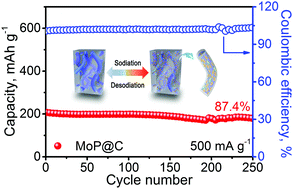Facile synthesis of a molybdenum phosphide@carbon nanocomposite as an advanced anode material for sodium-ion batteries†
Abstract
Herein, the MoP@C nanocomposite was successfully fabricated via a facile sol–gel approach followed by an annealing process, which demonstrated excellent electrochemical properties as a novel anode for sodium storage. The addition of the surfactant Tween 80 led to the formation of strong P–C bonds, ensuring in situ formation of a thin carbon layer on the nanosized MoP particles, which could mitigate particle aggregation and maintain the stable framework. Moreover, owing to the synergistic effect between the MoP nanoparticles and the highly conductive carbon network, the MoP@C nanocomposite delivered high reversible capacity and a superior cyclability (maintaining 180.3 mA h g−1 after 250 cycles at 500 mA g−1). In addition, the sodium-storage mechanism of MoP was unraveled by the combined analyses of in situ X-ray diffraction and ex situ transmission electron microscopy, confirming an incomplete conversion reaction during the sodiation/desodiation process; this provided an insight into the structural evolution and Na+-ion storage performance of phosphide anodes.



 Please wait while we load your content...
Please wait while we load your content...